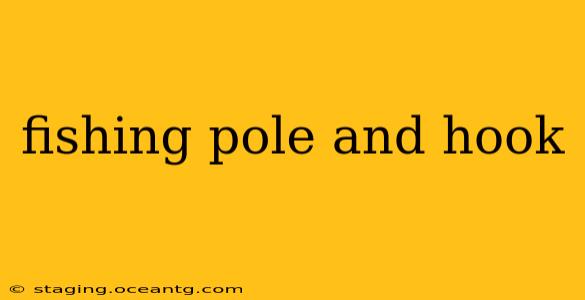Fishing is a rewarding hobby enjoyed by millions, but selecting the right fishing pole and hook can feel overwhelming for beginners. This comprehensive guide breaks down the essentials, helping you choose the perfect setup for your fishing style and target species. We'll cover everything from understanding different pole types to selecting the appropriate hook size and material.
What are the different types of fishing poles?
Fishing poles, or rods, come in a wide variety of materials, lengths, and actions. The best choice depends largely on the type of fish you're targeting and your fishing style.
-
Spinning Rods: These are versatile rods ideal for a wide range of fishing techniques, from casting lures to using bait. They are known for their sensitivity and light weight, making them great for finesse fishing.
-
Casting Rods: These rods are designed for heavier lures and baits, often used for targeting larger fish. They typically have a stronger backbone and are more powerful than spinning rods.
-
Baitcasting Rods: These rods are used with baitcasting reels, known for their precise casting control. They're excellent for anglers who want more control over their lure presentation, especially useful for working lures at specific depths or in specific areas.
-
Fly Rods: These specialized rods are used for fly fishing, a technique that uses artificial flies to attract fish. They are lightweight and flexible, requiring a delicate touch.
-
Spincast Rods: Designed for simplicity and ease of use, spincast rods are perfect for beginners. Their enclosed reel systems make them easy to cast and retrieve.
What size fishing hook should I use?
Hook size is crucial for successful fishing. Choosing the wrong size can result in missed bites or lost fish. Hook sizes are typically denoted by numbers, with smaller numbers representing larger hooks. Factors influencing hook size selection include:
- Target Species: Larger fish require larger hooks, while smaller fish require smaller hooks.
- Bait Size: The hook should be appropriately sized to accommodate your bait without being too large or too small.
- Water Conditions: In murky water, a larger hook might be beneficial for better visibility, whereas in clear water, a smaller hook may be more effective.
What types of fishing hooks are there?
Fishing hooks come in a variety of styles, each designed for a particular type of fishing or bait. Some common types include:
- Baithook: A classic hook design suitable for various bait types. Many variations exist (e.g., long shank, short shank).
- Circle Hook: Designed to hook fish in the corner of the mouth, minimizing injury and improving release rates.
- Treble Hook: A hook with three points, commonly used on lures.
- J-Hook: A standard J-shaped hook used with various baits and lures.
What material are fishing hooks made from?
Most fishing hooks are made from steel, but different types of steel offer varying levels of strength and corrosion resistance. Some common materials include:
- High-Carbon Steel: A very strong and durable material resistant to bending and breakage.
- Stainless Steel: Offers excellent corrosion resistance, making it ideal for saltwater fishing.
How do I choose the right fishing pole and hook combination?
The ideal combination depends heavily on your fishing goals. Consider these factors:
- Target Fish: Research the preferred baits and fishing techniques used to target your desired species.
- Fishing Location: Freshwater or saltwater fishing will require different gear choices. The structure of the fishing location (e.g., rocky bottom, weed beds) also influences the selection.
- Your Fishing Style: Are you a beginner looking for something easy to use, or an experienced angler seeking advanced techniques?
Choosing the right fishing pole and hook is crucial for a successful and enjoyable fishing experience. By understanding the various types of poles and hooks available and considering the factors mentioned above, you can make informed decisions and significantly improve your chances of catching fish. Remember to always check local fishing regulations and practice catch-and-release when appropriate.
